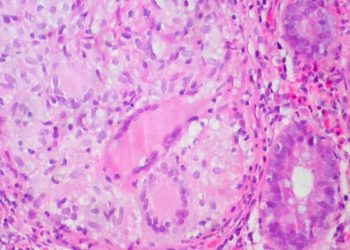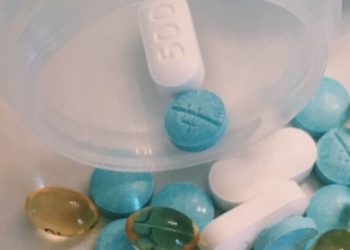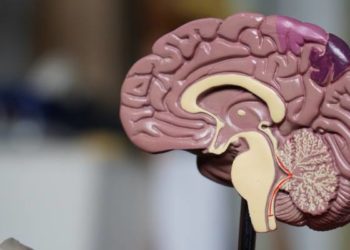2 Minute Medicine Rewind September 14, 2020
1. Anemia increased the risk of development of Crohn’s disease, inversely to hemoglobin concentration
2. Anemia was not associated with an increased risk of ulcerative colitis.
Evidence Rating Level: 2 (Good)
Though inflammatory bowel disease (IBD) can lead to anemia, whether anemia may be a surrogate marker for the early detection of ulcerative colitis (UC) or Crohn’s disease (CD) is yet to be determined. In this retrospective, population-based cohort study, patients with and without anemia (Hgb level <13g/dL in men, <12g/dL in women, according to WHO guidelines) were followed for new diagnoses of IBD. Information was collected from South Korea’s National Healthcare Insurance Service database which has a biannual screening program for almost all of its citizens. Patients who underwent screening in 2009 were assessed for IBD development with a lag period of one year (n=9,962,064) for a mean follow-up period of 7.3 years. Using an adjusted model that took into account differences due to age, sex, BMI, smoking, alcohol consumption, physical activity, income and GFR, there was a statistically increased likelihood of developing CD in the anemic group compared to the control, aHR 2.084 95% CI, 1.769-2.455 (p<0.001) which was also inversely proportional to hemoglobin concentrations. This model did not take into account urban residence, hypertension, dyslipidemia or metabolic syndrome which had different prevalences among the groups. Additionally, patients who did not have anemia in 2009 but who had developed anemia by their 2011 visit (352,464 patients of 6,696,826 individuals), also had an increased risk for developing CD (aHR 2.763, 95% CI 2.254-3.387). In both 2009 and 2011 analyses, male patients with anemia were more likely to develop CD than female patients (aHR, 1.432 vs. 1.240 and aHR, 4.311 vs. 2.178, respectively). However, there was no difference in risk of developing UC between patients who had anemia and those who did not (aHR, 0.972, 95% CI, 0.880-1.073, p=0.7594). Further studies will need to evaluate the types of anemia and their effects on the extent of disease. Nevertheless, these results support that anemic patients, especially with new diagnoses, may have an increased risk of developing CD, which was inversely proportional to their hemoglobin levels.
1. Aspirin use before diagnosis of primary malignancy is associated with decreased risk of developing depression, anxiety and stress-related disorders post-diagnosis.
2. Use of Non-aspirin NSAIDs were associated with a higher rate of depression, anxiety, and stress-related disorders.
Evidence Rating Level: 2 (Good)
Inflammation appears to contribute to the development of psychiatric disorders by affecting neurocircuitry and neurotransmitters. A recent meta-analysis suggested that non-steroidal inflammatory drugs (NSAIDs) may have a role in treating in patients with major depressive disorder and are relatively safe to take. Furthermore, there is often increased systemic inflammation in cancer patients, who are at a highly increased risk of having psychiatric comorbidities. In this retrospective cohort study, patients who were taking NSAIDs up to a year before diagnosis of a primary malignancy were followed for up to a year to determine the risk of developing new psychiatric illness including depression, anxiety and stress-related disorders. Patients were identified through the Swedish Cancer Register (n=316904) and statistical analysis adjusted for factors such as comorbidity, sociodemographic factors, cancer characteristics and indications for NSAID use. Aspirin use was associated with a lower rate of the above psychiatric illnesses (HR 0.88, 95% CI 0.81-0.97). Subgroup analyses also revealed a greater reduction in psychiatric disorders if the patient was a current user of aspirin versus a former user (HR 0.84, 95% CI 0.75-0.93 vs. HR 1.01, 95% CI 0.88-1.17, respectively), with a low dose of aspirin versus medium or high (HR 0.88, 95% CI 0.80-0.98 vs. HR 0.96, 95% CI 0.77-1.19 vs. HR 1.17, 95% CI 0.73-1.86, respectively), and in long-term users versus short-term (HR 0.84, 95% CI 0.76-0.94 vs. 1.07, 0.92-1.25). Non-aspirin NSAID use, however, was associated with a higher rate of depression, anxiety, and stress-related disorders (HR 1.24, 95% CI 1.15-1.32). One major limitation this study faced was that the Prescribed Drug Register used to track NSAID use could not account for over-the-counter NSAID use; however, this is unlikely to affect the results on aspirin use as low-dose aspirin is mostly prescribed in Sweden. Ultimately, aspirin use, especially current, long-term and low-dose, may be associated with decreased risk of development of depression, anxiety and other stress-related disorders after cancer diagnosis. Further research, however, must be done to clarify these mechanisms through potential randomized controlled trials.
1. Intravitreal bevacizumab injections for central serous chorioretinopathy show long-term outcomes of complete remission in 90% of patients,
2. Thick choroids and serous retinal detachment at baseline were risk factors for recurrence.
Evidence Rating Level: 2 (Good)
Central serous chorioretinopathy (CSC) is an ocular disease characterized by retinal detachment due to the presence of serous fluid. Though acute CSC is often self-limiting, treatment is often recommended to decrease risk of irreversible visual loss. Chronic CSC can also lead to permanent visual defects. Treatment with photodynamic therapy is more superior and consistent than intravitreal anti-VEGF medications but requires specialized equipment and may result in unwanted complications. Intravitreal anti-VEGF medications, including intravitreal bevacizumab injections (IVBI), thus have a role in treatment despite clinical outcomes being more inconsistent. The long-term treatment outcomes of IVBI injections has not been studied. In this retrospective, interventional, single-center study, patient information was extracted from those who underwent IVBI treatment for CSC (which included injections every 4 weeks until complete resolution (CR) was achieved) and had at least a 2-year follow-up (mean follow-up 35 months). Information on a total of 44 patients and 45 eyes was collected, among which 40 eyes were able to achieve complete remission. The primary outcome, to measure treatment response, showed that of the 40 eyes with at least one CR, 20 had developed at least one recurrence with an average duration of 11.6 months ± 6.4 months from CR to first recurrence. As well, the average number of IVBI required to reach first CR did not differ significantly among eyes that had or did not have previous recurrences (2.6 ± 1.6 vs. 2.9 ± 1.9, p=0.658). The secondary outcome, to determine if there are any factors that are related to recurrences, revealed patients with baseline characteristics of thick choroids (subfoveal choroidal thickness > 300um, B=1.980, p=0.019) and serous retinal detachment (B= -2.580, p=0.032) were associated with higher risk of recurrence. This study confirms the potential of IVBI as a potential treatment option for those desiring treatment and avoiding or are unable to access PDT therapy, as 90% of eyes were able to achieve at least one complete remission.
1. High volume fluid injections are not effective for treatment of chronic Achilles tendinopathy, including for pain and activity levels, in the intermediate-term.
Evidence Rating Level: 1 (Excellent)
Achilles tendinopathy, most commonly occurring in the midportion, is a frequently seen overuse injury for which initial management involves exercise combined with load management. Many of these patients however continue to have symptoms years after diagnosis and one-third of non-responders require surgery, necessitating the need for early, conservative therapy. Patients with chronic Achilles tendinopathy are observed to have neovascularization and infiltration of nerves. These physiological changes are suggested to play a role in the chronic pain component of this condition and previous studies have shown an association between ultrasound Doppler flow of the neovascularized vessels and patient-reported severity of symptoms. Recently, a novel technique of injecting high volumes of fluid (saline and lidocaine) with or without corticosteroids has been used based on the theory that large fluid volume will destroy neovascularization. Studies have shown symptom improvement in the short term (6-12 weeks) but not as much in the intermediate term and have been cohort studies or randomised controlled trials (RCTs) with low sample size. In this double-blind, placebo-controlled single-centre RCT, 80 adults with chronic midportion Achilles tendinopathy were randomised 1:1 to either high volume injection (50 mL total) or placebo (2 mL total) of a 4:1 ratio of 0.9% sodium chloride to 1% lidocaine. Patients had to have undergone a minimum of six weeks of exercise treatment which did not reach a satisfactory outcome, had painful Achilles tendon swelling, and detectable Doppler flow (either intratendinous or peritendinous). Patients were stratified according to pre-injury activity levels and were continued on exercise programs. Primary outcome was the VISA-A questionnaire (Victorian Institute of Sports Assessment-Achilles for measuring pain and activity) at 24 weeks and secondary outcomes were patient satisfaction, return to sport, degree of ultrasonographic Doppler flow, visual analogue scale on 10 hop test, power and flexibility of gastrocnemius and soleus muscles, pain detect questionnaire and pain coping inventory. Both high volume and placebo injections significantly improved VISA-A scores at 24 weeks (40.4, 95% CI 32.0-48.7 to 59.1, 95% CI 47.9-69.1 and 36.9, 95% CI 27.1-46.8 to 58.5, 95% CI 47.9-69.1) however there was no statistically significant difference between the groups (0.5 points, 95% CI -17.8 to 18.8). Similarly, none of the secondary outcomes showed statistically significant difference between the two groups at 24 weeks. However, Doppler flow assessment of the patients who had intratendinous neovascularization (n=33 in high volume, n=37 in control) showed successful disappearance of flow significantly more in the high volume group (26/33) than the control group (11/37) (p<0.001) but this successful procedural effect was not seen in any of the outcomes. The results of this study suggest there is no benefit of high volume fluid injection for patients with chronic Achilles tendinopathy.
1. Administration of vaginal lactoferrin 4 hours before amniocentesis decreased markers of oxidative stress.
Evidence Rating Level: 2 (Good)
While reactive oxygen species (ROS) are a necessary part of metabolism, excessive ROS can result in a condition, Oxidative Stress, which is associated with many negative pregnancy outcomes such as spontaneous abortion, recurrent miscarriage, preterm labour and preterm pre-labour rupture of membranes. Lactoferrin, a naturally found glycoprotein that has antimicrobial properties, has antioxidant properties due its ability to sequester Fe3+ and anti-inflammatory properties. In this open-label, randomized, single centre pilot study, 60 pregnant patients undergoing amniocentesis at 16 weeks were randomized in a 1:1:1 ratio either receive vaginal lactoferrin 300 mg 4 hours before amniocentesis, vaginal lactoferrin 12 hours before amniocentesis or no treatment (control). A portion of the amniotic fluid sample that was collected was used for analysis. Lactoferrin administration 4 hours before the procedure decreased the concentration of thiobarbituric acid reactive substances (TBARS, as a measure of ROS, p<0.0001), decreased oxidative stress index (OSI) (p<0.0001), and increased total antioxidant status (TAS, 35% higher than control p<0.0001, 17% higher than lactoferrin at 12 hours, p<0.001). Lactoferrin administration 12 hours beforehand was associated with decreased concentration of TBARS but to a lower extent (p<0.05). There was no statistically significant difference for OSI or TAS, possibly owing to the short half-life of lactoferrin. Vaginal lactoferrin administration may have potential as adjuvant in dealing with inflammation-related adverse pregnancy outcomes. Future studies with increased sample size, longitudinal design and viable dosing regimens to sustain longer effects are needed to understand the impact of vaginal lactoferrin on pregnancy-related outcomes.
Image: PD
©2020 2 Minute Medicine, Inc. All rights reserved. No works may be reproduced without expressed written consent from 2 Minute Medicine, Inc. Inquire about licensing here. No article should be construed as medical advice and is not intended as such by the authors or by 2 Minute Medicine, Inc.







